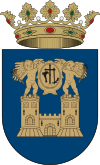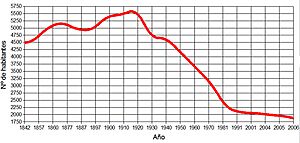Chelva facts for kids
Quick facts for kids
Chelva
|
||
|---|---|---|
|
||
| Country | ||
| Autonomous community | ||
| Province | Valencia | |
| Comarca | Los Serranos | |
| Judicial district | Llíria | |
| Area | ||
| • Total | 190.6 km2 (73.6 sq mi) | |
| Elevation | 800 m (2,600 ft) | |
| Population
(2018)
|
||
| • Total | 1,498 | |
| • Density | 7.859/km2 (20.356/sq mi) | |
| Demonym(s) | Chelvano, chelvana | |
| Time zone | UTC+1 (CET) | |
| • Summer (DST) | UTC+2 (CEST) | |
| Postal code |
46176
|
|
| Official language(s) | Spanish | |
Chelva is a town in Spain, located in the Valencian Community. It is part of a region called Los Serranos. While its name in Valencian is Xelva, the people there speak Spanish.
Contents
Exploring Chelva's Landscape
Chelva covers a large area, about 192 square kilometers. The town is nestled in the middle of the mountains. Over half of its land is covered by beautiful Mediterranean woodlands.
Rivers and Mountains
Two rivers flow through Chelva: the Chelva River and the Turia River. The Turia River eventually reaches the Mediterranean Sea near Valencia. These rivers do not meet in Chelva itself, but in a nearby town called Domeño.
Chelva is also home to several tall mountains. The highest is Cerro de la Nevera, standing at 1,259 metres or 4,131 feet. Other notable peaks include La Atalaya (1,157 metres or 3,796 feet) and Pico del Remedio (1,054 metres or 3,458 feet). You can also find many natural springs here. Some of the most famous ones are Berra, Gitana, Gorgol, Sabina, and Cortina.
Chelva's Climate
Chelva has a climate that is mostly dry and sunny, typical of the Mediterranean. It gets some rain in autumn and spring. Winters can be cold, and snow often falls in the higher mountain areas.
People of Chelva
Chelva's population has slowly decreased over many years. In 1794, about 7,200 people lived there. Today, fewer than 2,000 people call Chelva home. Most people live in the main town. However, some also live in smaller nearby villages. These villages include Villar de Tejas, Ahíllas, Alcotas, Mas de Caballero, Mas de Sancho, and El Cerrito.
Population Changes Over Time
The number of people living in Chelva has changed a lot throughout history. After 1794, the population generally went down. This trend continued into the 20th and 21st centuries.
A Look Back at Chelva's History
Chelva has a very long history, with signs of people living there for thousands of years.
Ancient Times
The oldest discoveries in Chelva are ancient paintings from the Neolithic era (New Stone Age). From the Bronze Age, archaeologists found a site in Nieva del Medio. The ancient Iberians also lived in Chelva. Remains of their villages have been found in Torrecilla and Castillejo de Alcotas. They left behind pottery with cool geometric designs, and you can still see some of their old walls.
The most important ancient remains are from the Roman period. One amazing example is the Peña Cortada aqueduct. This ancient water channel stretches across several towns, including Chelva. Its exact destination is still a bit of a mystery!
Moorish and Christian Eras
The Chelva we know today started in the 11th century. At that time, the Moors (Muslim rulers) built a strong fortress. The original town center, called "Benacacira," grew up next to this castle. It was protected by a wall with four gates. One gate, San Cristobal, can still be seen today. Because of these strong defenses, Chelva was a very important town during Moorish rule.
Christian forces, led by Peter II of Aragon, took control of Chelva in 1194. The Muslims briefly got it back in 1214. But by 1238, Christian troops took permanent control of the town.
In 1390, more Christians moved to Chelva. King John I gave the title "Viscount of Cheva" to Pedro Ladron de Vilanova. This title later belonged to other families, including the Frigolas family.
Later Conflicts
During the Revolt of the Brotherhoods in the 16th century, rebel troops took over the town. Later, in 1839, during the Carlist War, Chelva was fortified. General Cabrera used it as a hospital during this conflict.
Fun Local Festivals
Chelva celebrates many exciting festivals throughout the year!
San Antón
This festival is on January 17th. On the closest weekend, people in Chelva build huge bonfires. They try to get the most "jewels," which are actually live chickens! During this same weekend, Chelva also hosts an international oral storytelling festival called Cuentantón.
Holy Week
During Holy Week, besides the usual religious events, Chelva has a special tradition. On the first Sunday of Easter, after a procession, thousands of "aleluyas" are thrown from the top of the church. These are small, blessed pieces of paper with religious words. People try to catch them because, according to tradition, they bring good luck if you put them behind doors and windows in the shape of a cross.
May Fiesta
The May fiesta is on April 30th and is a fun display of traditional culture. People walk around the town with musicians, singing "Mayos." These are funny songs that, a long time ago, boys used to sing to girls to get their attention.
Youth Week
Youth Week takes place in July and is packed with activities. The most popular event is the paella competition. On Friday night, everyone gathers in the Plaza Mayor (main square) to compete and make the best paella. After the cooking, a band plays music for everyone to enjoy.
Our Lady of Remedio
This festival in August lasts a whole week! It includes many activities, processions, and different bands playing music every night. There are also sports competitions like indoor football, marathons, chess, and fishing. The week ends with exciting fireworks!
See also
 In Spanish: Chelva para niños
In Spanish: Chelva para niños







